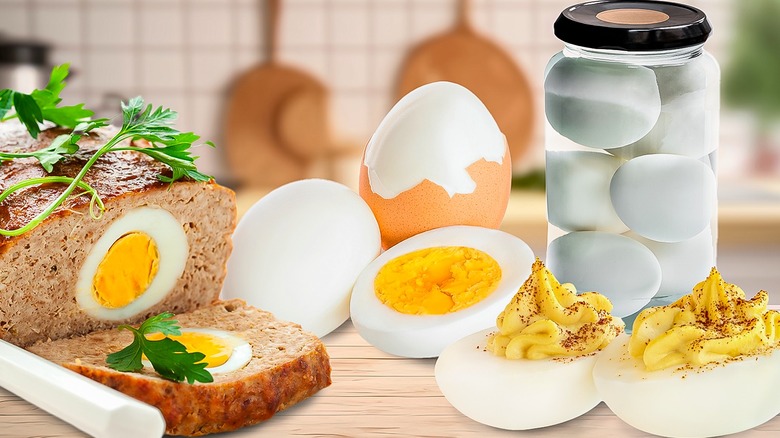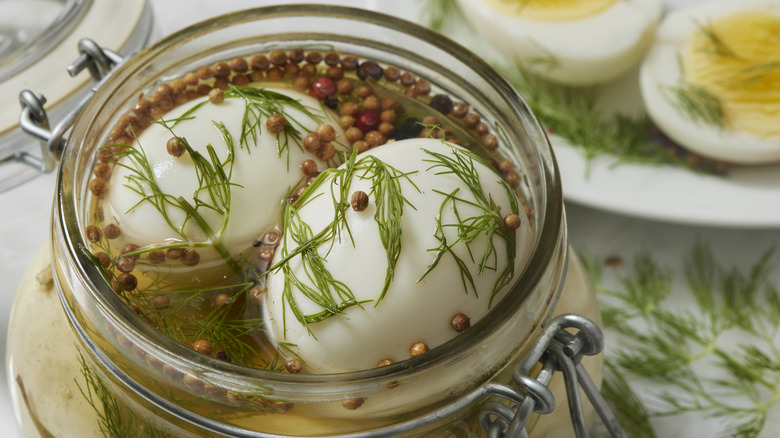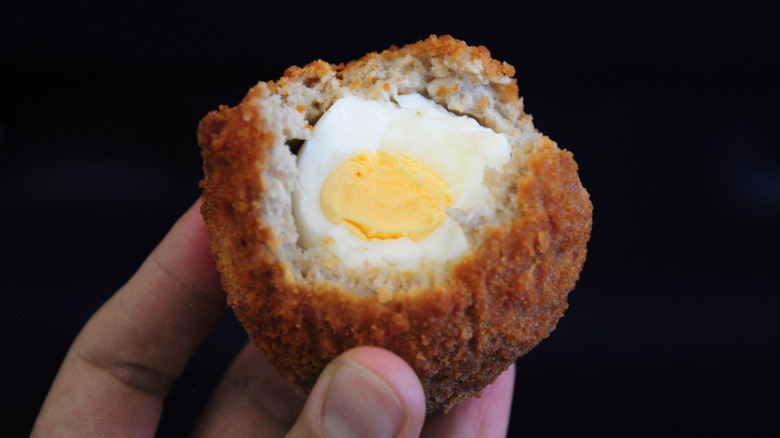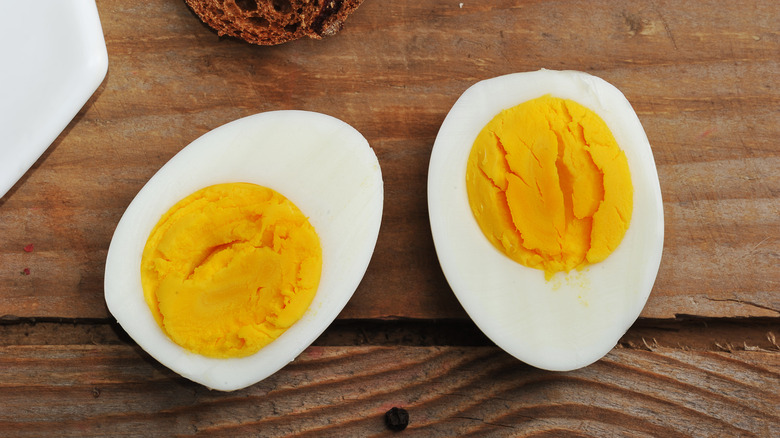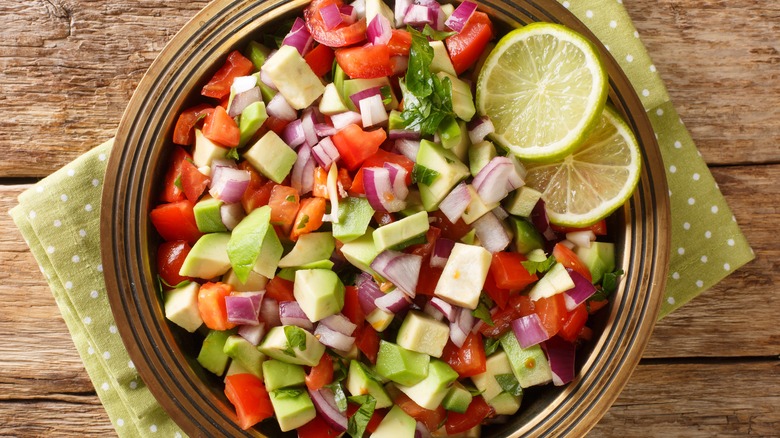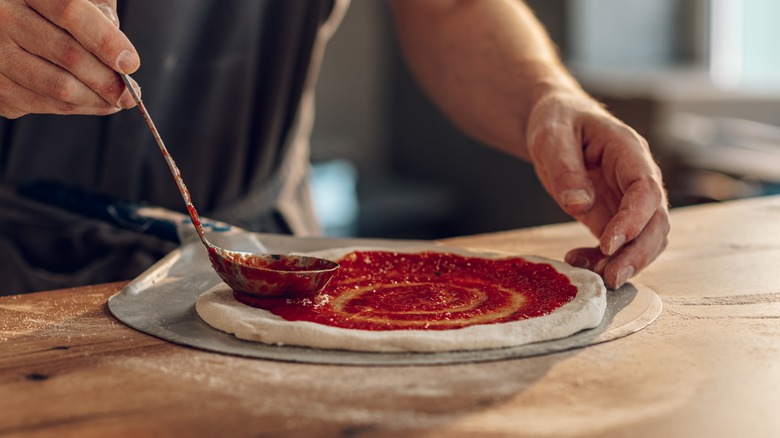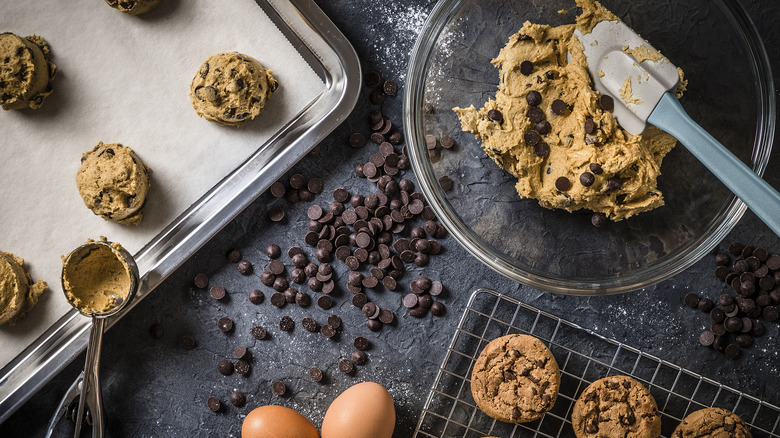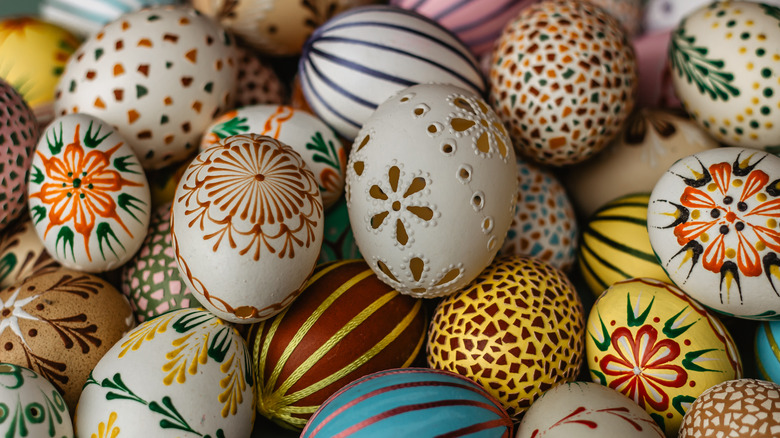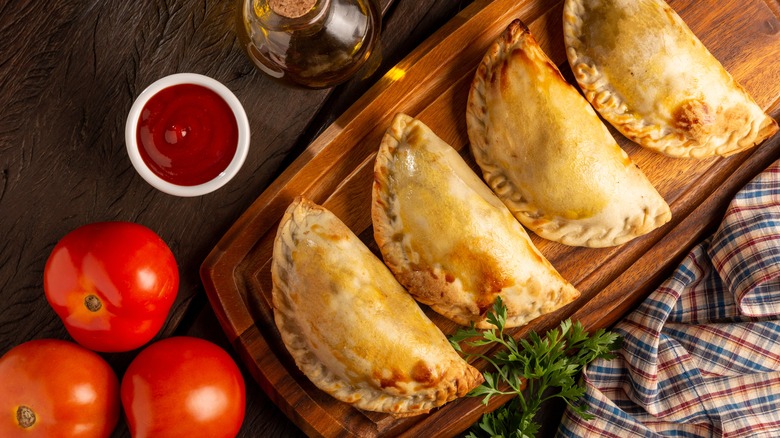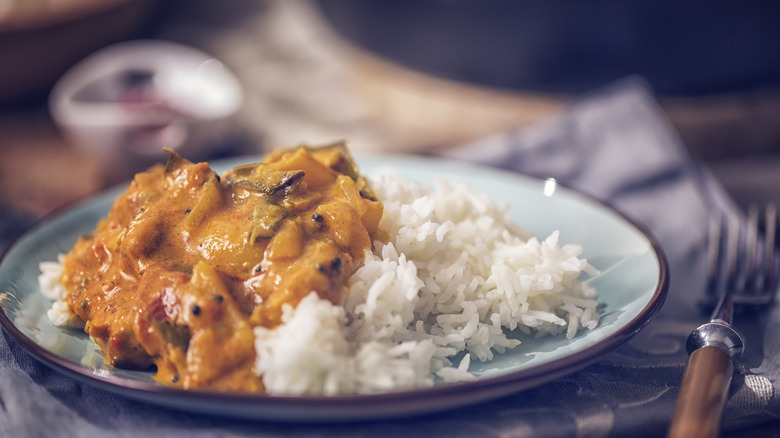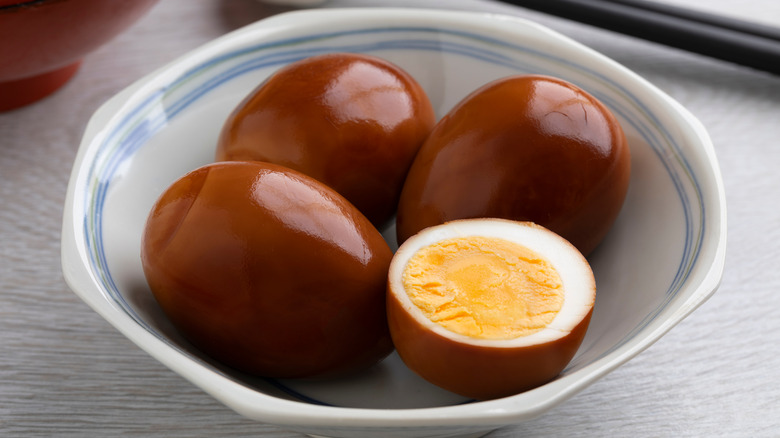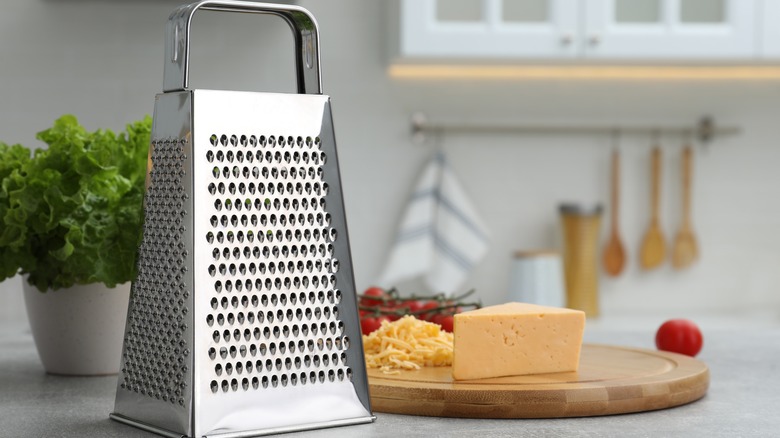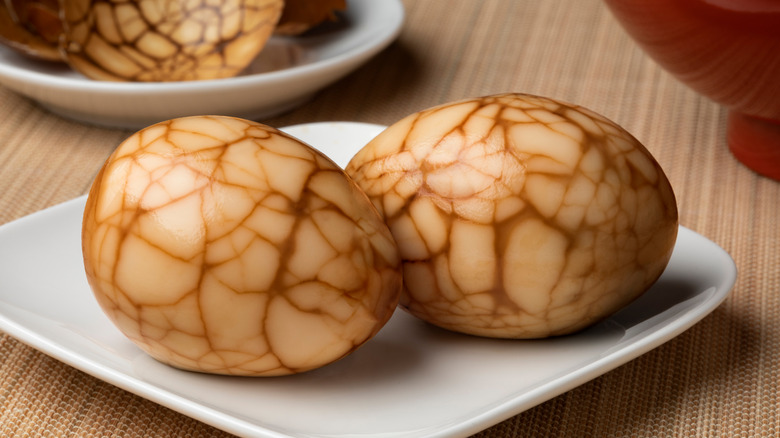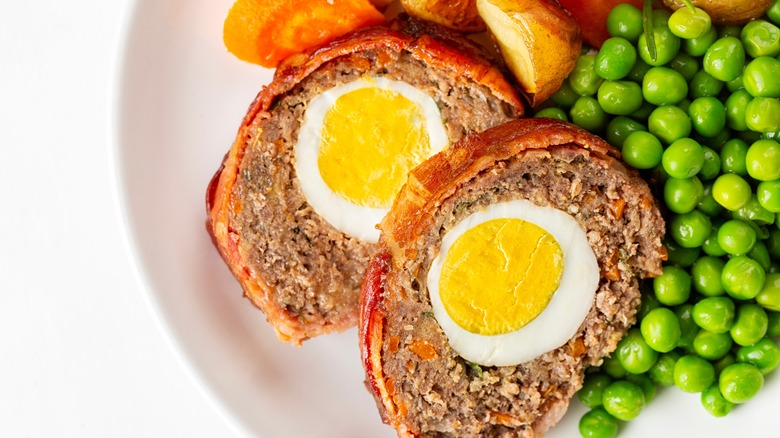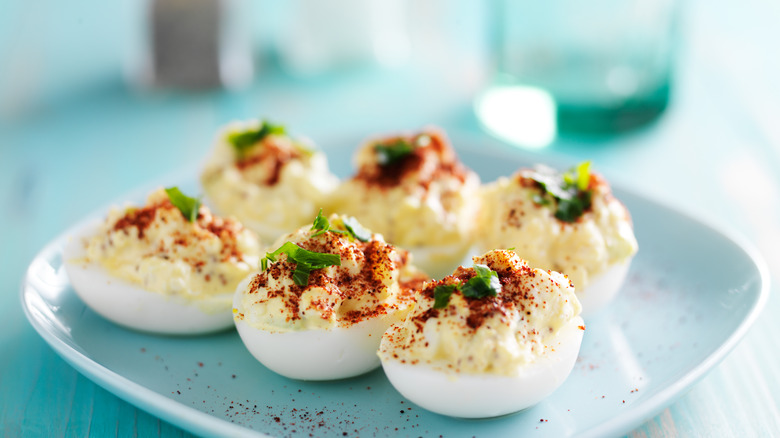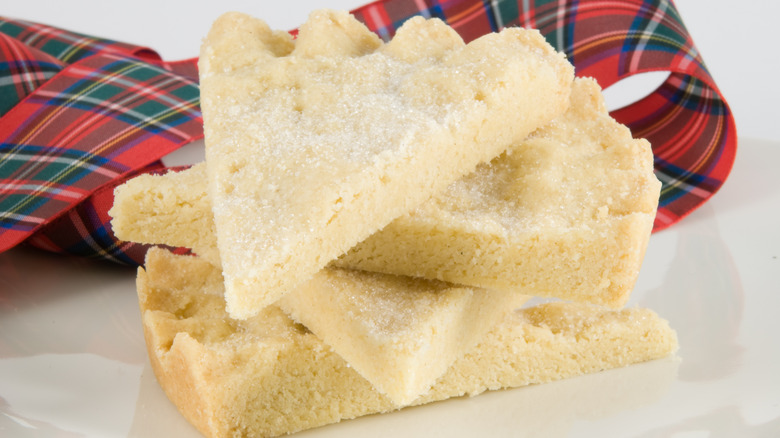15 Creative Uses For Hard-Boiled Eggs
We may receive a commission on purchases made from links.
Hard-boiled eggs, with their firm whites and creamy yolks, stand as chameleons in the realm of gastronomy. These unassuming orbs are marvels of simplicity and versatility, transcending their humble origins to become stars in a multitude of dishes. The transformation begins with the egg's preparation — in this case, boiling. Behind the hard, exterior shell, the soft inside mutates into a harder but still malleable substance that can be cut, shaped, or flattened at will. But after that, each egg is your oyster.
Whether served solo with a dash of salt and pepper or adorned with a dollop of mayonnaise, hard-boiled eggs boast a timeless appeal. They are the cornerstone of classic dishes like deviled eggs and egg salad, where their subtle richness provides a harmonious backdrop for complementary ingredients. But hard-boiled eggs also lend themselves to innovative creations — like eggs pickled in beet juice — or can be fashioned into funny shapes. So let's take a look at some of the most interesting ways in which hard-boiled eggs can be transformed from their rather unassuming state into something curious, new, and exciting.
Pickle them for salads
Slicing some hard-boiled eggs and putting them in a salad has been done before. But doing this with pickled hard-boiled eggs is another story. The pickling — whether you choose beet juice, allspice berries, herbs, or something else — will lend the eggs a unique tang that will transform the flavor of your salad.
Just remember that whichever main ingredient you choose for your pickling, you also need to include vinegar and sugar, as these are the additions that do the pickling. For example, in this herby pickled eggs recipe, you'll need to start by heating some vinegar and sugar with garlic, fennel seeds, and peppercorns. Once both your hard-boiled eggs and the vinegar solution have cooled, combine the two and let the pickling commence. For this recipe, you can also throw in thyme and fresh tarragon for added flavor, and you can always squeeze in a few drops of beet juice for color.
Try frying hard-boiled eggs
You probably know all about fried eggs — that delightful breakfast staple that involves cracking open an egg and cooking it in a pan until the whites have solidified and the yolk remains nice and gooey. But there is also such a thing as a fried boiled egg, meaning an egg that has already been hard-boiled and is then fried with searing hot oil. This is the technique you'll need if you want to try Yotam Ottolenghi's fried boiled eggs in chili sauce. Start by rolling your cooked and shelled eggs in corn flour before frying them and coating them with a chili sauce created by using the oil from the frying along with tomato paste, garlic, onions, rehydrated chilies, chili flakes, and a Middle Eastern spice blend like ras el hanout. Serve the dish for a decidedly elevated version of a hard-boiled egg breakfast.
And if you find that you like frying eggs, consider dishes that involve deep-frying hard-boiled eggs as well. Popular in Britain, Scotch eggs are hard-boiled eggs wrapped in sausage meat and breadcrumbs before being deep-fried. Another option is to deep-fry your deviled eggs. Or simply deep-fry hard-boiled eggs on their own by dabbing them until they're dry before dredging them in flour, beaten eggs, and breadcrumbs, in that order. Then refrigerate them for 30 minutes so they don't fall apart as you deep-fry them to golden perfection.
Play around with shapes
Have you ever cut into a hard-boiled egg to find that the shape of the yolk was anything other than round? A tool available on Amazon now allows you to hard-boil your egg while the yolk takes on new shapes, such as hearts or stars. While this nifty little trick won't change the taste of your eggs, it can do a lot for presentation.
That said, using this device takes longer — about 20 minutes in all — than it takes for a regular hard-boiled egg, so you'll have to decide whether it's worth the effort. If you want something cute but expedient, it may be simpler and faster to just make your hard-boiled egg the old-fashioned way, peel it, slice it, and cut out fun shapes with a mini cookie cutter. Just make sure the eggs have fully cooled before you attempt this, or they will surely fall apart.
Stuff hard-boiled eggs with kachumbari
You may know that Kenyan cuisine features delicious meat stews and ugali, a corn-based starch that is often enjoyed alongside said stews. But there is also mayai pasua, a hard-boiled egg filled with chopped vegetables. After the eggs are boiled, they are split open and stuffed with kachumbari, a salad combination including fresh tomatoes, onions, cilantro, and lemon juice. You can top this with hot sauce for a good kick.
To make this snack at home, peel and split open your hard-boiled egg to prepare it for the filling. To make the salad, be sure to chop everything finely, as the center of an egg is a pretty small space, and larger chunks of vegetables will likely fall out. What you get is a tasty, healthful snack that couldn't be easier to prepare.
Put hard-boiled egg slices on pizza
People put the most outlandish things on pizza. Peanut butter, the contents of a burrito, and horsemeat are just a few that come to mind. Given this precedent, the thought of putting sliced boiled eggs on pizza doesn't seem all that wacky, yet many people don't think about it when they're considering what to do with their leftover hard-boiled eggs.
Thankfully Brazil — and its sizable population of Italian immigrants — is here to remind us that hard-boiled eggs can and do go on pizza, especially in the form of a pizza à Portuguesa, which also includes fresh tomatoes, sausage chunks, ham, onions, peppers, and olives. When making it at home, be sure to put the hard-boiled egg slices on the pizza only after it comes out of the oven, or they might end up overcooked. The rest of the ingredients should go on the pizza before it is cooked, so they can sink into the cheese and blend their flavors together.
Stir them into cake batter or cookie dough
It seems pretty par for the course that a cookie recipe should call for eggs. Unless it's vegan, pretty much all cookie recipes call for this ingredient, which acts as the primary binding agent and is necessary to keep the ingredients from falling apart during the cooking process. But in almost all cases, the eggs are raw when they go into the dough. This makes the mixture easier to manipulate.
But what if you're fresh out of fresh eggs? Turning to those leftover hard-boiled eggs doesn't seem like such a bad idea. It's either that or bundling up and going to the store. As it turns out, boiled egg yolks can act as a binding agent, as long as you press them through a sieve — practically turning them into a paste — before stirring them into your dough. Just be sure to adjust the cooking time, as the dough will be less moist, and a longer cooking time might dry out the cookies.
Decorate them with fun colors
Late winter and early springtime is prime time to start planning Easter decorations and activities. One of many Easter egg decorating ideas is to dye hard-boiled eggs with fun colors. First of all, get out your ingredients and tools: aside from the hard-boiled eggs, you'll need a muffin tin in which to keep all your various dyes, and a whisk for holding the eggs as you dip them, unless you're happy to get colorful fingers.
You can prepare your own healthy dyes at home with natural ingredients. A little bit of beet juice is all it takes to turn a white egg bright pink, while a turmeric mixture will stain your eggs yellow in perpetuity (along with your countertop and clothes, so be careful with that one). Other great ideas include using purple cabbage and spinach. For added flair, you can also apply temporary tattoos on your eggs.
Make empanadas de pino
When you're all out of ideas for what to do with your hard-boiled eggs, it's time to look to cuisines outside of North America. In this case, we suggest taking a cue from South America and its tradition of making delicious empanadas, which are often filled with spiced meats or vegetables. One version popular in Chile, the empanada de pino, often includes boiled eggs, along with ground beef, onions, and olives.
To prepare this delightful finger food, you can follow the basics of any empanada recipe to help prepare the dough and learn how to fold it. As for the filling, sauté ground beef, cumin, paprika, and onions before adding flour. Finally, scoop this filling, once cooled, onto the flattened empanada dough, add sliced olives and a wedge of hard-boiled egg, and fold the dough shut before cooking.
Include it in your curry
One of the great things about curry is that you can add practically any protein, from juicy beef to silky tofu, and it will welcome the ingredient with open arms. The same is true for eggs, although these are not often found in restaurant curries, to our detriment. Instead, use those eggs to pack your homemade curry with flavor and texture by following our spicy egg curry recipe.
Start by making your own curry paste by blitzing chopped onions with chili powder, garam masala, cumin, turmeric, and ground coriander. For added spice, include a fresh chili pepper as well. Once the canned tomatoes are added and the curry is ready, gently place halved hard-boiled eggs in the pan and coat them with the sauce. This curry recipe is so simple to make from scratch that if you already have hard-boiled eggs on hand, the whole thing will only take you about 25 minutes to prepare.
Marinate hard-boiled eggs in soy sauce
Boiled eggs are so versatile partly because they don't have a strong taste of their own. They can blend into practically any dish without greatly altering the overall flavor. That said, they do have a lot to add in terms of texture, which is one of the reasons why we love them. This texture comes especially in handy when using the marinating hack that takes eggs to the next level: saturating them in soy sauce to create Japanese shoyu tamago, used to elevate salads or noodles. One method for making these is dipping peeled hard-boiled eggs into hot soy sauce and marinating them for about five minutes. Or you can soak them for at least two hours in a mixture of soy sauce, warm water, sugar, and sherry vinegar.
Japan isn't the only culture to marinate its eggs in soy sauce. Taiwan also dines on a food called lu dan, which involves marinating peeled hard-boiled eggs in a mixture of soy sauce with flavorings like rice wine, spices, and sugar. Meanwhile in Korea, a similar egg snack is prepared with soy sauce, garlic, onion, and chili peppers. In other words, options abound for soaking hard-boiled eggs with soy sauce.
Grate them on everything
One simple but unusual way to use eggs in a salad, on toast, or for countless other ways is to use your cheese grater for hard-boiled eggs. This removes the need for laborious chopping, and spreads the eggy goodness more evenly across your food. For instance, next time you make avocado toast, you can grate hard-boiled eggs over the mashed avocado, or mix them right in to create a smooth spread.
This method can be applied across the board, and is especially useful for those who like eggs but might feel queasy about the possibility of consuming an undercooked egg with a runny yolk. Grating fully cooked hard-boiled eggs provides a similar flavor while also mimicking a softer texture. For the same reason, grated hard-boiled eggs can also be slipped into dishes that might not normally use eggs at all, like a grilled cheese sandwich or lasagna.
Soak them in tea for marbled deviled eggs
Why make eggs and tea for breakfast separately when you can enjoy them both in a single bite? That's what happens when you soak your hard-boiled eggs in tea and other flavorings to create marbled deviled eggs. The first step involves simmering hard-boiled eggs with gently cracked shells in a mixture of black tea, soy sauce, and Chinese five-spice powder, before marinating them in the cooled mixture for at least 24 hours. The flavorful mixture results in hard-boiled eggs with a taste reminiscent of Southern sweet tea.
After marination is complete, the result may not look all that interesting, but as soon you fully peel the shells off of the eggs, you'll see a fun spiderweb pattern emerge. Finally, prepare deviled eggs with these by using your favorite recipe. Between their spiciness and intriguing spiderweb design, these deviled eggs will impress your guests in every conceivable way.
Pack hard-boiled eggs into meatloaf
Hard-boiled eggs can be sliced, chopped, grated, and cut into any which way ... but sometimes, the best thing to do is to just leave them whole, as in the case when you add hard-boiled eggs to meatloaf. Not only will this recipe help you get rid of those leftover boiled eggs, but they'll also provide a surprise for anyone who doesn't know they're concealed in the main course.
To make this, be sure to properly boil your eggs. No soft- or medium-boiled eggs allowed, or they may collapse inside the meatloaf once exposed to added heat in the oven. Follow your favorite meatloaf recipe and place the mixture in your baking pan, then put the boiled eggs on top, and scoop more of the mixture over the eggs until they end up buried in the middle of the log, completely covered on all sides. Since the eggs are already fully cooked, you don't have to worry about the meatloaf ending up soft in the middle.
Try different varieties of deviled eggs
A basic deviled egg recipe — which includes just eggs, mayonnaise, mustard, vinegar, seasoning, and paprika — never disappoints. But you'd be missing out if you didn't also explore the vast range this dish has, which spans a whole realm of new and exciting ingredients and cooking methods. For one, there is the smoked trout and olive deviled eggs recipe, which involves the complex yet complementary flavors of pickled shallots, hard-boiled eggs brined in beet juice, zesty olive relish, and savory trout.
For your next Halloween party, you might also want to try smoky pumpkin deviled eggs, which involve blending pumpkin puree into the yolk mixture and decorating it with a little green chive to make it look like a pumpkin. Or if you want your eggs for breakfast, opt for the everything bagel-inspired deviled eggs recipe, which calls for a mixture of butter, breadcrumbs, chives, cream cheese, and everything bagel seasoning.
Add hard-boiled eggs to shortbread
Baking is a precise science, so it's important to know what each ingredient brings to a recipe, and in what form those ingredients may best contribute to the final product. For example, if you want ultra tender shortbread, try adding hard-boiled egg yolk to the mix. With this trick up your sleeve, you can say goodbye to those dry and crumbly shortbreads that seem to make a mockery of your efforts.
The problem is most likely tied to overworking the batter: The more you stir, the more the gluten develops, which leads to that crumbly texture. According to Allrecipes, the boiled egg, and especially the yolk, can stop too much gluten from forming by providing a buffer between the proteins in wheat flour that would otherwise bond when flour comes into contact with wet ingredients. Although some gluten is necessary for your baked goods to stick together, too much can be harmful. Hard-boiled eggs help manage this balance.
